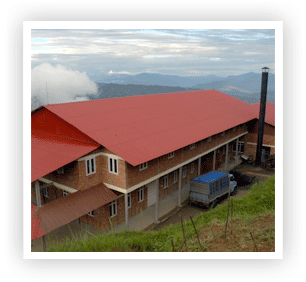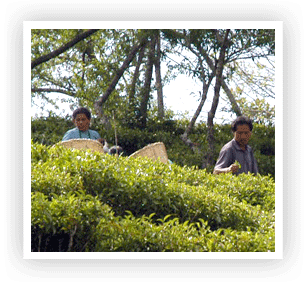Recently we have bought two excellent teas from this garden. Both are from summer season, but they are total opposites.
Himalayan Imperial Black is hand-processed, dark tea with long unbroken leaves, concerning the process of manufacture it is very close to oolong teas.
On the other hand, Himalayan Ever Green is big leaved green tea with vegetal and slightly smoked taste.
Jun Chiyabarai Tea Estate Story
Location
The tea garden in the eastern Himalayan region of Nepal, located in the hills around Hile in Dhankuta district. This is North 27o 01′ East 087o 19′. The garden falls within an elevation of 1600 – 2000 meters above sea level. This area is about 200 km east from Kathmandu; 55 km west of Ilam in Nepal and 65 km west of Darjeeling, India.
 Size
SizeThe garden is quite small compared to the gardens in countries like India and Sri Lanka. Total area is only 75 hectares out of which we have planted 50 hectares only. The remaining areas will be planted out in the next two or three years. The planting was started in mid 2002 only so the tea plants are quite young.
Cultivars / plants
In the tea garden itself different quality tea cultivars were brought from Nepal and Darjeeling and as far away as Taiwan and Japan and planted out.
From Nepal came plants (cuttings and seeds) from the original seeds plants given by the Qing Emperors (1850’s-1860’s) to Nepal’s rulers. Locally available plants from Nepal Tea Board like AV2 were also planted.
From Darjeeling we got cultivars like T1, T78 and Phoobshering 312 and many others. Also valuable cuttings and seeds from China seeds plants were obtained through friends and well wishers.
From Japan common variety like Yabukita and some special tea plants growing wild in the forests in Miyazaki ken were planted out.
From Taiwan plants like Si Ji Chun (Shikiharu) and Chin Sin Oolong from Dong Ding in Nantou were brought and planted.
Very few tea gardens in the region have the type of tea plants that we have in Jun Chiyabari. Perhaps this diversity combined with the soil and climate not to speak of the skills of the tea master which gives our teas a special character.
Manufacturing Season
The manufacturing season starts in March and continues until November. As is with the region, there are four harvest seasons: First, Second, Monsoon & Autumn Flush. The start and ending of each Flush is totally climate dependant.
Types of tea manufactured
We make teas that range all along the oxidisation spectrum from 0% to 100%; from Specials to standard Orthodox Black. You will find various lines of oxidised, partially oxidised and non oxidised teas. Each offers a distinct cup, nose and mouth. Our teas have unique but subtle, complex and delectable aroma and taste.
 Size
Size









































